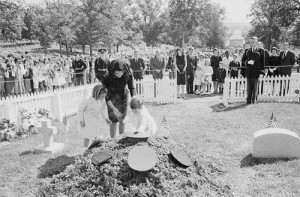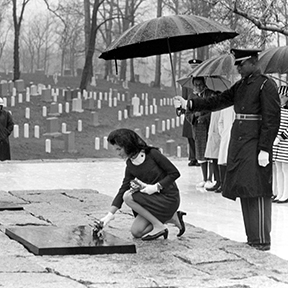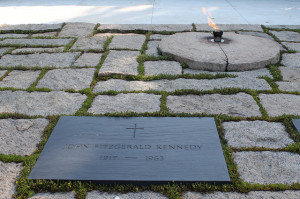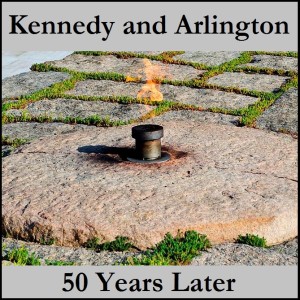The Eternal Flame
In a four-part series, Preservation Arlington looks back at the assassination of President John F. Kennedy, which had a major impact on Arlingtonians, and all Americans, and which culminated in Kennedy’s funeral, which indelibly changed the face of Arlington National Cemetery.
For this final piece, we take a look at the Kennedy grave, with its eternal flame, one of Arlington’s most iconic and historically significant places, in honor of the president’s burial 50 years ago today.
Aside from the Tomb of the Unknowns, the Kennedy grave site may be the most important burial place in Arlington National Cemetery — at least in terms of aesthetics and cultural significance. Quiet, dignified, and somber, it is the most-visited spot in the cemetery, bringing millions of visitors from all over the world since the president was laid to rest there, 50 years ago today. The president had visited the site himself only eight months earlier, in March 1963. According to historians, the president peered down the slope from Arlington House toward the Memorial Bridge that day and mused, “I could stay here forever.”
The funeral was held on a Monday, which dawned crisp and clear. Hundreds of thousands of people had waited for hours to walk past Kennedy’s bier as it lay in state in the U.S. Capitol — “the greatest and most solemn wake in history,” as TV newsman Hugh Downs called it. That morning, an estimated one million people lined the streets of Washington, D.C.. and the Arlington Memorial Bridge to watch the funeral procession from the Capitol to St. Matthew’s Cathedral where the funeral mass was held, and finally to the burial site at Arlington.

(Photo courtesy of the Army Corps of Engineers)
After the tumult of the previous three days, the procession went smoothly and the burial ceremony was serene. Behind the scenes, however, there had been a scramble to secure the exact location and grave that Mrs. Kennedy had wanted in time for the burial.
The Temporary Flame
When President Kennedy and his wife Jackie visited Paris in 1961, they could not know that one of their sightseeing stops would play an important and enduring role in American history. The Kennedys had visited the Arc de Triomphe with French President Charles de Gaulle and noted that its memorial to the French Unknown Soldier featured an eternal flame.
Two years later, on November 24th, 1963, Jackie Kennedy was accompanying her husband’s body to the Capitol building to lie in state when the idea of an eternal flame suddenly came to her, according to author William Manchester. There had already been a squabble over the preferred site of the president’s final resting place, which many thought should be in his native Massachusetts. But at Jackie’s insistence, and with support from Robert F. Kennedy and Defense Secretary Robert McNamara, it was approved that the president would be buried at Arlington, and with an eternal flame. (Kennedy remains only the second president buried there, after William Howard Taft. McNamara, who died in 2009, is buried not far away from Kennedy.)
Working tirelessly overnight, a team from the U.S. Army Corps of Engineers built a temporary eternal flame, with a mound of evergreen boughs to cover the mechanisms, at the head of the chosen grave site. They also slightly moved the chosen site so that it fell exactly on the monumental axis between Arlington House and the Lincoln Memorial.
The task fell to expert gravedigger Clifton Pollard to prepare the site for burial on Sunday the 24th. When cemetery Superintendent John C. Metzler expressed regret that this hard task fell on a Sunday morning, Pollard replied: “It’s an honor for me to be here.” (Pollard himself is buried at Arlington too, in Section 31, only steps away from the Kennedys.)
Col. Clayton Lyle led the engineering team who built the flame. “I got more publicity out of the eternal flame than anything else that I ever did,” he said later. “I considered it an honor to be a part of it, but I’d rather not have had to do it.”
The grave was surrounded by a grass plot and eventually framed by a white picket fence. But almost as soon as the funeral was over, plans were under way for a more permanent memorial.
An Enduring Design

(Cecil Stoughton, U. S. Army Signal Corps/John Fitzgerald Kennedy Library, Boston)
In November 1963, John Carl Warnecke was already “one of the busiest architects in the country,” as the Washington Post described him, when he received the devastating news that President Kennedy had been killed.
Warnecke had befriended the Kennedys years before and had earned their good graces in particular when the president asked Warnecke to help with a preservation problem. The General Services Administration had planned to raze historic Federal-style townhouses lining Lafayette Square and replace them with large government office buildings. Preservationists, with support from Mrs. Kennedy, opposed the plan.
Warnecke came up with the precedent-setting solution to save and renovate the townhouses and build the office buildings behind them. Jackie would later remember that thoughtfulness when the time came to choose a designer for her husband’s grave.
Originally, the Defense Department had slated three acres for a Kennedy memorial site, but Mrs. Kennedy personally asked McNamara to abandon the plans, saying that the family would need no more land than that which immediately surrounded the grave site. She trusted Warnecke to come up with an elegant and understated solution.
Warnecke studied numerous famous memorials and grave sites as he worked to develop the permanent Kennedy design, which would continue to incorporate an eternal flame. The final design included an simple burial site with grave markers that are flush with the ground, as well as an elliptical plaza that offered views of the cemetery, quiet contemplation space, and engraved quotations from Kennedy’s speeches. The grassy plot was eventually replaced with fieldstone laid in a flagstone pattern, which was considered more durable. Construction began in 1965 and was completed in July 1967.
“Seldom has there been such instant and unanimous approval of a new and important architectural design,” wrote Washington Post architecture critic Wolf Von Eckardt after its unveiling in the National Gallery of Art in November 1964. When construction was completed over two years later, the same critic described the grave this way: “Simple and honest, it is in perfect harmony with its place in nature and history.”
The Kennedy Grave Today

(Photo courtesy of Charles Atkeison/Flickr)
“After President Kennedy joined the ranks there,” wrote Robert Poole in his book about the cemetery, On Hallowed Ground, “nothing would be the same.”
In addition to the great crowds of tourists who visited the president’s resting place, the number of annual requests for interment at Arlington grew exponentially, which led to the greater restrictions on who can be buried at the cemetery that are still in place today.
Since 1963, the grave site has been altered several times, most notably to accommodate the burials of Jackie Kennedy in 1994 and the president’s brothers, Robert F. Kennedy (in 1968) and Edward M. Kennedy (in 2009). The grave site was most recently renovated earlier this year with an upgrade to the eternal flame. This required the first lighting of a temporary flame on the site since Kennedy’s funeral.
Rep. John Lewis, an icon of the Civil Rights movement who met with Kennedy in the White House in June 1963, said of Kennedy later, “The place for him in my heart is still real, still strong and deep….That drive, energy, the commitment, the dedication. The idea that we can go places as a nation and as a world community that we have never gone before. It is still there.”
This archival video shows most of the Kennedy procession and funeral from Washington, D.C., across the Memorial Bridge and on to Arlington Cemetery.
Selected Sources:
William Manchester, Death of a President, Little Brown & Company, 2013 (reissue)
Dean R. Owen, November 22, 1963: Reflections on the Life, Assassination, and Legacy of John F. Kennedy, Skyhorse Publishing, 2013
Robert M. Poole, On Hallowed Ground: The Story of Arlington National Cemetery, Walker & Company, 2009
Wolf Von Eckardt, “A Critical Look at the Kennedy Grave,” The Washington Post, 26 March 1967

2 thoughts on “The Eternal Flame”
The caption under the first photo is dated incorrectly. Should be 1964 not 1864.
Thank you! With the anniversary of the Gettysburg Address this month too, I guess we got our historical time periods mixed up! The caption has been corrected. Thanks for your eagle-eye!